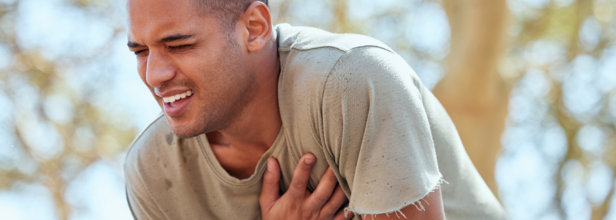
(Credit-Canva)
Sitting For Elongated Hours? Yoga To Relieve Lower Back Pain
Yoga is one of the best ways to ensure your body’s well-being. Whether you are trying to build muscle, increase your flexibility or relieve pain, yoga helps. The stretches and poses in yoga can help you work all your muscles as well as joints. One of the most popular ones are back exercises.
There are many reasons why your back may be hurting. With people spending more hours sitting on desks, whether it is for their jobs, studying etc. When you exercise your back, not only will you strengthen your back muscles, but you will also strengthen your core. Weak core muscles can also contribute to back pain during everyday activities. Medical experts agree that any exercise that strengthens the core is beneficial for lower back pain. While studies suggest yoga isn't significantly superior to other forms of exercise and stretching, it may offer long-lasting pain relief.
Downward-Facing Dog
This classic pose stretches and strengthens almost all muscles, relieving pressure on the spine and easing back tension. Start on hands and knees, lift knees off the floor, and raise your tailbone towards the ceiling, pressing into your hands. For a deeper lower back stretch, bend your knees and lengthen your tailbone upwards.
Child's Pose
Despite appearing restful, Child's Pose effectively stretches the back and hip muscles. It's also a great way to de-stress, especially before bed. Begin on hands and knees, bring big toes together, widen knees, and press hips back towards heels. Walk arms forward, resting forehead on a block, folded arms, or the mat, allowing shoulders to soften.
Reclined Half Pigeon
This variation of Pigeon Pose stretches the hip rotators and flexors. Tight hips can contribute to lower back pain, making this stretch beneficial. Lie on your back with bent knees, cross your left ankle over your right thigh, and thread your left arm through the leg triangle. Hold your right shin or hamstring with both hands, flex both feet, and hug legs towards your body, breathing into hips and lower back.
Triangle Pose
Triangle Pose effectively stretches both the hips and the spine. Facing the long edge of your mat, extend arms to a T and step feet wide. Turn your right toes to the top of the mat and angle your left foot slightly inward. Engage your core as you reach your right arm and torso forward, placing your right hand on the ground or a block outside your right ankle. Extend your left arm straight up, gazing towards your left thumb or straight ahead.
Cat-Cow Pose
Moving between Cat and Cow stretches the back muscles, lengthening and increasing the spine's flexibility. Start on hands and knees, aligning hands under shoulders and knees under hips. Tuck toes for stability and engage your lower abdomen. Inhale, relax your belly down, draw shoulder blades together to open your chest, and lift your gaze into Cow Pose. Exhale, arch your back into Cat Pose, pressing the ground away and tucking your chin to your chest.
Standing Forward Bend
This pose stretches the hamstrings and back muscles. Stand with feet shoulder-width apart and knees loose. Exhale as you hinge at your waist and bend forward, reaching towards the floor. Bending your knees helps lengthen the lower back and deepen the stretch in the legs. Hold for 10 to 20 breaths and repeat as needed.
Low Cobra
Low Cobra helps strengthen the back muscles, promoting healthy lower back alignment and body awareness. Lie on your stomach with forehead on the mat, slide palms back to align thumbs with lowest ribs, and press down through the tops of your feet. Inhale, engage your back body, and curl your chest up, pressing palms into the mat and drawing shoulder blades down and in. Hold for one to five breaths and repeat two to three times.

Credits: Canva
Can You Be Fit And Still Be At Risk Of A Cardiac Arrest?`
In a shocking incident, an Air India Express pilot in his 30s collapsed and died of cardiac arrest shortly after successfully landing his flight from Srinagar to Delhi. According to reports, he vomited in the cockpit and later passed away. The tragedy has turned the spotlight on the rising cases of sudden cardiac arrest (SCA) among seemingly healthy young adults—especially professionals in high-stress jobs.
Fit But Vulnerable: Why It Still Happens
It’s easy to assume that physically fit individuals are protected from heart trouble, but fitness isn’t always a shield against cardiac events. Sudden cardiac arrest doesn’t necessarily require years of poor lifestyle choices or obvious health issues.
Unlike a heart attack, which is caused by a blockage in blood flow to the heart, SCA occurs when the heart’s electrical system malfunctions, often due to irregular heartbeats or arrhythmia. In many cases, a heart attack can also trigger a cardiac arrest if it interferes with the electrical activity of the heart.
So why is this happening to young adults, especially those in their 30s?
Stress, Sleep, and the Hidden Risks
Jobs with erratic schedules—like those of pilots, doctors, or corporate professionals—can strain the heart over time, especially when chronic stress and poor sleep are involved. When you're stressed, your body releases hormones like adrenaline and cortisol, which increase your heart rate and blood pressure. If this continues over time, the heart muscle can weaken or develop rhythm issues.
In this case, the pilot reportedly vomited before collapsing—this could be linked to the vagus nerve, which connects the brain and the heart. During cardiac stress, the body can misinterpret reduced blood flow as a stomach issue, leading to nausea or vomiting.
Conditions like stress cardiomyopathy—a temporary weakening of the heart triggered by intense emotional or physical stress—can also interfere with heartbeat regulation, leading to SCA even in the absence of blocked arteries.
Why Your 30s Are Not “Too Early” for Heart Trouble
Studies are beginning to confirm what doctors have noticed in clinics: cardiac risks are increasing among the young. A 2023 study published in Circulation noted that people in their 30s are increasingly experiencing heart-related emergencies, and lifestyle factors are a major contributor.
This includes smoking, excess alcohol, recreational drug use, and even overuse of energy drinks, which overstimulate the heart. Dehydration, often overlooked, also plays a role—it can cause an electrolyte imbalance (especially sodium and potassium), which is crucial for steady heart rhythms.
Should Frequent Flyers Be Worried?
Frequent flyers or those working in aviation should be mindful. Long-haul flights, changing time zones, and limited movement all contribute to cardiovascular stress. The solution? Stay hydrated, move regularly during flights, and monitor any pre-existing conditions. Keeping medication in hand baggage and avoiding heavy meals, alcohol, or caffeine mid-air is also key.
Preventing the Worst: What You Can Do
Cardiac events don’t wait till your 50s. Experts now recommend heart screening from age 25 onward, especially if there’s a family history or stressful lifestyle. Regular exercise, a balanced diet, hydration, and stress-management routines—such as yoga, meditation, or even tech breaks—are more important than ever.
And yes, good sleep matters just as much as your gym routine. A rested body can recover from stress better—and so can your heart.

(Credit-Canva)
Walking Like This Helps You Burn More Calories!
Walking is one of the best exercises you can do. It engages all your important muscles and helps you burn a lot of calories. It is one of the most accessible forms of exercise that is great for beginners. There are also many ways that you can increase how many calories you burn. One such variation is the Nordic walking. Harvard Health Publishing tells us that Nordic walking is like taking your regular walk and adding a boost with special poles. This exercise was originally created for cross-country skiers to keep up their training during the summer months when there's no snow.
You can say it is similar to cross-country skiing but with no ice and on solid ground! Now, it's become a popular activity for everyone, especially older adults. It's a great way to get moving and get some fresh air, you may think using that the poles people are using is to support themselves, but these poles are meant to mimic the ski poles that boost you on the snow, these poles helps you engage more muscles than just regular walking, turning a simple stroll into a full-body workout. It's easy to learn and can be done almost anywhere.
Why It's Good for You?
Nordic walking is fantastic because it works both your heart and your muscles. It's like getting two workouts in one. Harvard Health Publishing explains that when you walk normally, you mostly use your leg muscles. However, when you add the poles, you start using your arms, shoulders, and core too. This means you're burning more calories, which is great for weight management. It also helps improve your heart health by increasing your heart rate. Plus, it can lower your bad cholesterol and raise your good cholesterol, which is good for your arteries. Nordic walking can also make you feel better mentally by reducing stress and anxiety. Furthermore, because the poles help with balance, you're less likely to fall, which is especially important as you get older.
How Can You Get Started?
To start Nordic walking, you'll need a pair of special poles. These aren't the same as regular hiking poles. Nordic walking poles have a special strap that fits around your wrist like a glove, which helps you push yourself forward. You can find these poles at most sporting goods stores or online. Once you have your poles, you can start practicing the techniques. There are two main techniques: double poling and single poling. Single poling is easier to learn, so it's a good place to start. Just swing one pole at a time, matching the movement of your legs. As you get better, you can try double poling, where you plant both poles at the same time.
The good news is that almost anyone can try Nordic walking. It's a low-impact exercise, which means it's gentle on your joints. Even if you have balance problems, the poles can actually help you feel more stable. However, it's always a good idea to talk to your doctor before starting any new exercise program, especially if you have any health conditions. Once you have your doctor's approval, you can choose a place to walk. You can walk on sidewalks, trails, or in parks. Just make sure the surface is relatively even and safe. You can even join a Nordic walking group, which is a great way to meet new people and stay motivated.

(Credit-Canva)
Sitting In This Yoga Pose Can Boosts Digestion And Relieve Constipation
Unlike what many people believe, yoga can be easily added into your daily routine and activities. Yoga asanas can be done throughout the day, without making it too overwhelming. For example, doing the mountain pose along with some stretches after you wake up to doing the child pose, followed by cobra pose before bed. Another such yoga pose is Vajrasana, or the thunder or the diamond pose. This is a sitting pose which is not only vital for our posture, but also for digestion.
Doing this yoga pose, after eating for about 10-15 minutes, improves digestion and is a great aid to relieve constipation. This pose is often recommended as a meditational pose or a breathing pose, as it brings about calmness and focus on our body. There are many benefits of Vajrasana.
Benefits of Vajrasana
- Improve concentration
- Reduce feelings of anxiety
- Increase body flexibility
- Lower blood pressure and heart rate
- Help manage symptoms of type 2 diabetes
It's important to remember that yoga should not replace any existing medical treatments, such as medication, unless you have discussed this with a healthcare professional.
How to Perform the Vajrasana Pose
Here is a step by step guide on how to do the Vajrasana pose:
Step 1
Begin by kneeling on the floor. Using a yoga mat can make this more comfortable.
Step 2
Bring your knees and ankles close together, pointing your feet straight back in line with your legs. The soles of your feet should face upward, with your big toes touching.
Step 3
As you exhale, slowly sit back onto your legs. Your buttocks will rest on your heels, and your thighs will rest on your calves.
Step 4
Place your hands on your thighs and gently adjust your pelvis slightly forward or backward until you find a comfortable position.
Step 5
Breathe slowly in and out as you straighten your spine to sit up tall. Imagine the top of your head pulling you upward and gently press your tailbone down towards the floor.
Step 6
Keep your head straight, looking forward with your chin parallel to the floor. Rest your hands on your thighs with your palms facing down and your arms relaxed.
Tips To Make Vajrasana More Comfortable
To make Vajrasana more comfortable or less challenging, several adjustments can be helpful. For those who experience ankle pain, placing a folded blanket or even another cushion under the shin, allowing the toes to extend off the back, can provide relief. If knee pain is an issue, try positioning a rolled or folded blanket or towel across the calves and tucking it behind the knees for added support. Finally, for general sitting discomfort, placing a yoga block horizontally between the feet can help support some of your weight and reduce pressure on both the ankles and knees.
When Should You Avoid Doing Vajrasana?
It's a good idea to talk to your doctor before starting any new yoga program. They can advise you on how yoga might affect your current health and suggest ways to avoid potential problems. It is often recommended that you should not perform Vajrasana if you have knee problems or have recently had surgery or a spinal cord condition, especially involving the lower part of your spine. Another reason why you should avoid this is if you have intestinal ulcers, a hernia, or other intestinal issues.
© 2024 Bennett, Coleman & Company Limited

